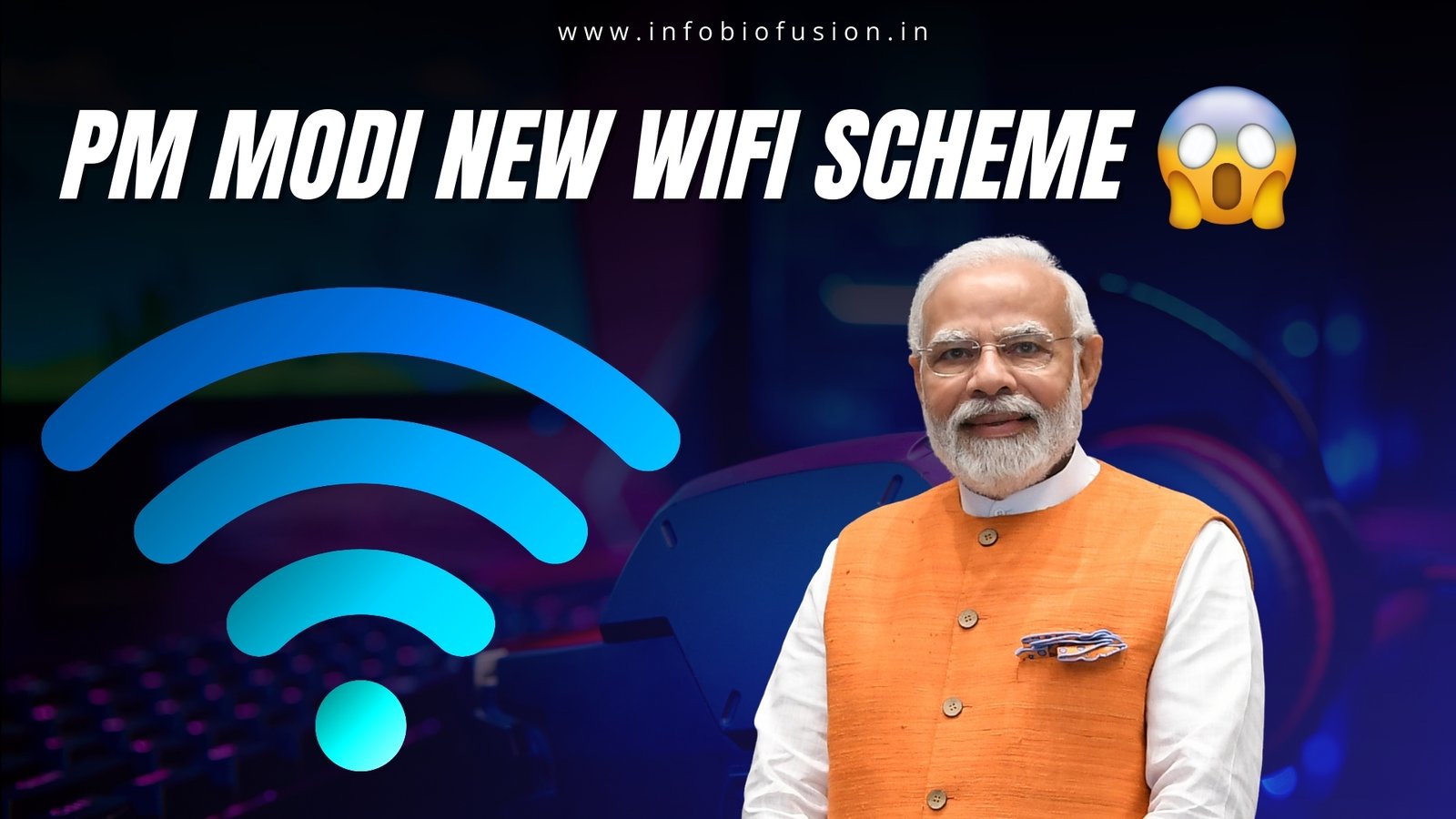The way India has changed in the last few years with the internet is something everyone talks about. People now use online banking, UPI for payments, kids study through apps, and even farmers check the weather or crop prices on their phones. The internet has become a part of daily life. But there is still one big problem, and that is connectivity. Not everyone gets fast and cheap internet. Many people, especially in small towns and villages, struggle with this. To solve this, Prime Minister Narendra Modi has announced a new plan that aims to give simple WiFi access to every user in the country.
This plan has already become a hot topic because it wants to make internet access as common as electricity or clean water. It is being seen as a big step to reduce the gap between cities and villages. Today, using the internet is not just about fun. It is almost like a basic need. Students who are preparing for exams, shopkeepers who want to grow their business, or families who just want to stay connected with loved ones all depend on it.
The most interesting part is that every user who registers will be able to connect to government WiFi networks in different towns and villages. People are even comparing it to the time when mobile phones first became cheap in India. Back then, nobody believed that almost every person would one day own a smartphone. And yet, it happened. In the same way, this WiFi plan is being seen as a step towards making the internet available for everyone, everywhere.
If you think about it, the benefits are huge. A shopkeeper in a small town can sell his goods online if he has a stable connection. Farmers can get updates on market prices or rainfall without waiting for someone to bring the news. Children in villages can join online classes, download study material, and learn new things just like kids in the city. These small changes can completely change how families live and work.\
WEBSITE NOW
Of course, many people wonder about the cost. Data packs in India are already cheaper compared to most countries, but unlimited packs are still not affordable for all. That is why this scheme is about building a public WiFi system that users can log into without paying too much. The idea is not to make profits but to give access. Places like railway stations, bus stops, schools, and community halls could soon have free or low-cost WiFi, so no student or worker is left behind.
Another way to look at this is digital empowerment. India has been working for years on projects like Digital India and BharatNet, which focus on bringing broadband to rural areas. This new plan is like the next step. It makes the internet part of daily life and reduces dependence on mobile towers that often fail in faraway villages.
There is also a business angle to it. Imagine a small café in a town turning into a WiFi hotspot. The owner will get more customers, and young people will have a place to sit, study, or work. Slowly, such spaces can become centers of learning and even small innovation hubs. Experts believe this could help startups grow from smaller cities and not just metros like Delhi or Bengaluru.
At the same time, we cannot ignore the challenges. A plan of this size always faces hurdles. Building infrastructure and keeping the service strong will cost money. Security is another worry. Public WiFi is often less safe than private networks, so data safety is important. The government is planning login systems where every user has verified details, making misuse less likely. Campaigns will also guide people on how to use public WiFi safely.
Private companies will also have a role here. Telecom firms, internet providers, and even startups can partner with the government. Public WiFi is not really competition for them. In fact, it can create more users. Someone may start using WiFi at a railway station and later decide to buy a private broadband connection at home once they see how useful the internet is. This can push the digital economy forward.
The timing of this scheme is also important. The pandemic showed how vital internet access is. From remote work to online classes to telemedicine, everything now needs a strong connection. Even today, many families in villages miss out on opportunities just because their internet is weak. This plan could change that and help rural India catch up with the rest of the world.
There is also a bigger picture. India has always wanted to become a knowledge-based economy. Making WiFi available for everyone is like building a digital highway. Just like real highways connect towns and improve trade, digital highways will connect people, ideas, and businesses.
In the end, this scheme is not only about WiFi. It is about changing how people live in the modern world. It is about giving a student in a small village the same chance as a student in a big city. It is about helping a small business dream bigger. It is about making sure India’s digital growth includes everyone. Of course, the success will depend on how the plan is carried out, but the idea behind it is strong. And if history is any guide, whenever Indians are given the right tools, they make the most of them and often surprise the world with their creativity and hard work.
The way India has changed in the last few years with the internet is something everyone talks about. People now use online banking, UPI for payments, kids study through apps, and even farmers check the weather or crop prices on their phones. The internet has become a part of daily life. But there is still one big problem, and that is connectivity. Not everyone gets fast and cheap internet. Many people, especially in small towns and villages, struggle with this. To solve this, Prime Minister Narendra Modi has announced a new plan that aims to give simple WiFi access to every user in the country.
This plan has already become a hot topic because it wants to make internet access as common as electricity or clean water. It is being seen as a big step to reduce the gap between cities and villages. Today, using the internet is not just about fun. It is almost like a basic need. Students who are preparing for exams, shopkeepers who want to grow their business, or families who just want to stay connected with loved ones all depend on it.
The most interesting part is that every user who registers will be able to connect to government WiFi networks in different towns and villages. People are even comparing it to the time when mobile phones first became cheap in India. Back then, nobody believed that almost every person would one day own a smartphone. And yet, it happened. In the same way, this WiFi plan is being seen as a step towards making the internet available for everyone, everywhere.
If you think about it, the benefits are huge. A shopkeeper in a small town can sell his goods online if he has a stable connection. Farmers can get updates on market prices or rainfall without waiting for someone to bring the news. Children in villages can join online classes, download study material, and learn new things just like kids in the city. These small changes can completely change how families live and work.
Of course, many people wonder about the cost. Data packs in India are already cheaper compared to most countries, but unlimited packs are still not affordable for all. That is why this scheme is about building a public WiFi system that users can log into without paying too much. The idea is not to make profits but to give access. Places like railway stations, bus stops, schools, and community halls could soon have free or low-cost WiFi, so no student or worker is left behind.
Another way to look at this is digital empowerment. India has been working for years on projects like Digital India and BharatNet, which focus on bringing broadband to rural areas. This new plan is like the next step. It makes the internet part of daily life and reduces dependence on mobile towers that often fail in faraway villages.
There is also a business angle to it. Imagine a small café in a town turning into a WiFi hotspot. The owner will get more customers, and young people will have a place to sit, study, or work. Slowly, such spaces can become centers of learning and even small innovation hubs. Experts believe this could help startups grow from smaller cities and not just metros like Delhi or Bengaluru.
At the same time, we cannot ignore the challenges. A plan of this size always faces hurdles. Building infrastructure and keeping the service strong will cost money. Security is another worry. Public WiFi is often less safe than private networks, so data safety is important. The government is planning login systems where every user has verified details, making misuse less likely. Campaigns will also guide people on how to use public WiFi safely.
Private companies will also have a role here. Telecom firms, internet providers, and even startups can partner with the government. Public WiFi is not really competition for them. In fact, it can create more users. Someone may start using WiFi at a railway station and later decide to buy a private broadband connection at home once they see how useful the internet is. This can push the digital economy forward.
The timing of this scheme is also important. The pandemic showed how vital internet access is. From remote work to online classes to telemedicine, everything now needs a strong connection. Even today, many families in villages miss out on opportunities just because their internet is weak. This plan could change that and help rural India catch up with the rest of the world.
There is also a bigger picture. India has always wanted to become a knowledge-based economy. Making WiFi available for everyone is like building a digital highway. Just like real highways connect towns and improve trade, digital highways will connect people, ideas, and businesses.
In the end, this scheme is not only about WiFi. It is about changing how people live in the modern world. It is about giving a student in a small village the same chance as a student in a big city. It is about helping a small business dream bigger. It is about making sure India’s digital growth includes everyone. Of course, the success will depend on how the plan is carried out, but the idea behind it is strong. And if history is any guide, whenever Indians are given the right tools, they make the most of them and often surprise the world with their creativity and hard work.

Hi, I’m Sai from Tech Legends Agency. I share simple guides, reviews, and tips on Android apps, gadgets, and digital tools to make your daily life easier.

